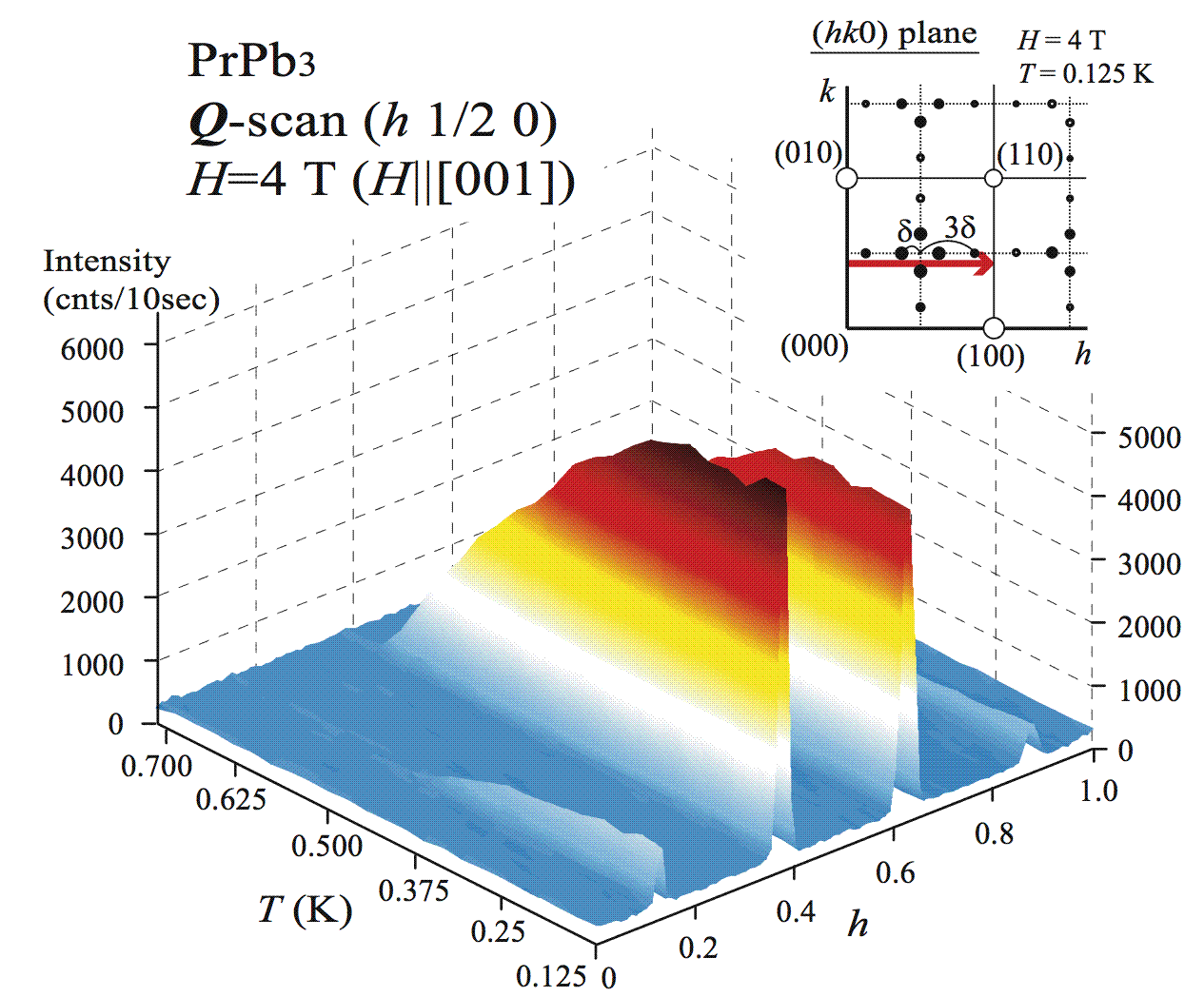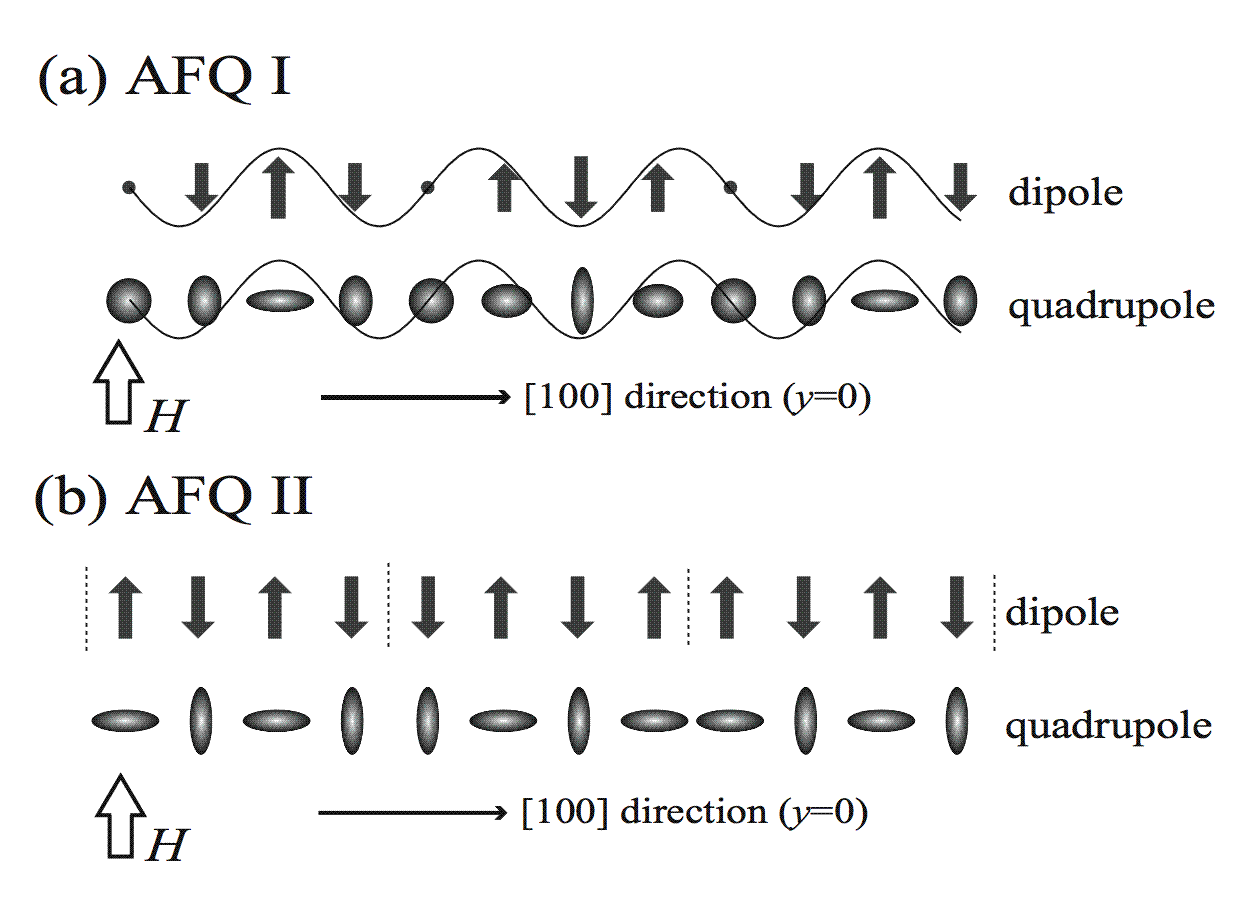
Last updated: Apr. 14, 2010
◆◆ Modulated Quadrupole Ordering in PrPb3 ◆◆
Because of a strong intra-atomic spin-orbit coupling, the orbital degeneracy in f electron systems is described in terms of quadrupole moments which are rank-2 tensor operators of the total angular momentum J. The orbital ordering in f electron systems, i.e., a spontaneous lifting of the orbital degeneracy by interactions, therefore is a phase transition of quadrupole moments. Following magnetic orderings, one refers to uniform alignment of the quadrupole moment as a ferroquadrupolar state, whereas an ordering having a staggered quadrupolar component is called an antiferroquadrupolar (AFQ) state.
The AFQ ordering systems whose ordering structure has been identified are still lmited in number. All the AFQ structures known so far have simple q vectors (simple alternations of the quadrupole moments). One of the reasons for this could be the short-range nature of quadrupolar interactions. Nevertheless, it has been argued theoretically that an indirect quadrupolar interaction of RKKY-type might exist in some intermetallic systems; the existence of long-range quadrupolar interactions would not rule out the possibility of modulated or incommensurate AFQ structures.
Here we report on our recent study on the AFQ structure of the cubic intermetallic compound PrPb3. The 4f electrons of this compound are almost localized, having an orbitally degenerate level in the crystalline electric field ground state. PrPb3 is known to exhibit a second order phase transition at 0.4 K, which has been considered (but not confirmed microscopically) as an AFQ transition. Very recently, we have succeeded in identifying the AFQ structure of PrPb3 by means of neutron scattering measurements in a magnetic field. To our surprise, the ordered state turns out to be a long-period modulated quadrupole phase.
Figure 1 shows the results of the Q scans performed in a field of H=4 T applied parallel to the [001] axis. Clear magnetic superlattice reflections are observed at q=(1/2±δ 1/2 0), δ~0.125 below the AFQ transition temperature TQ~0.65 K. These reflections are distinguished from the ordinary antiferromagnetic ones because their intensity continuously decreased with decreasing field and vanished at H=0. This behavior is exactly what one would expect for the AFQ phase. Below~0.4 K, 3rd harmonic reflections are observed at q'=(1/2±3δ 1/2 0), indicating the structure turns into a square shape at low T.

The magnetic and quadrupole structures of PrPb3 obtained from the present measurements are shown in Fig. 2, where the ovals and the arrows indicate the expected quadrupole and induced magnetic structures, respectively. Generally, in an AFQ phase, an antiferromagnetic (AF) component compatible to the AFQ order parameter (OP) is induced in a field and gives rise to magnetic superlattice reflections. Below TQ, the induced AF moment parallel to [001] has the long-period modulated structure as shown in Fig. 2(a) (AFQ-I). The underlying AFQ moment is also expected to have the long-period modulation. This is the first observation of the quadrupolar ordering with a long-wavelength amplitude modulation. The AFQ OP is determined to be of O20 type (=2Jz2-Jx2-Jy2) from the polarization of the induced AF component. At lower temperatures and above 1 T, this state undergoes a 1st-order transition to an antiphase square structure denoted as AFQ-II in Fig. 2(b). Very interestingly, the non-square modulated phase AFQ-I is found to persist as T→0 at low field below 1 T. This observation suggests that the local quadrupole moment of Pr3+ is partially quenched by hybridization with conduction electrons (quadrupole Kondo effect).












